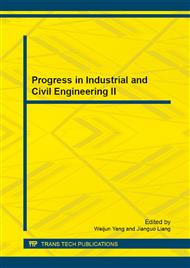p.221
p.227
p.233
p.237
p.243
p.248
p.252
p.256
p.262
Research on Liquefaction Characteristics of Saturated Undisturbed Loess under Different Level of Liquefaction
Abstract:
On the basis of the dynamic triaxial liquefaction test of the loess samples which were taken from the Shibei tableland, Guyuan city, and evaluating the liquefaction potential of the loess through laboratory experiment and response analysis. Then the liquefaction characteristics of saturated undisturbed loess under different level of liquefaction are analyzed based on the evaluation results. The results are shown that: when the saturated undisturbed loess liquefaction is light, dynamic stress is decayed barely, weak dynamic residual deformation is generated, pore water pressure begins to grow, the dynamic stress dynamic strain stagnant curves have not marked change, and the deformation of the soil is at viscoelastic stage. When the loess liquefaction is middling, attenuation of dynamic stress is not obviously, dynamic strain is increasing, amount of pore water pressure much higher than stage one, the long axis slope of hysteresis curves is reduced significantly, the sizes and shapes difference of adjacent hysteresis loop is obvious, and the deformation of the soil is at viscoelastic-plastic stage. When the loess is liquefied completely, dynamic stress is decayed evidently, dynamic strain increased dramatically, and its crest value could exceed 10%, the peak value of pore water pressure is sustainable increasing, and emerge the apparent fluctuation under the action of a drastic dynamic strain, the form of the stagnant curves tend to be irregular, the loess is in elastic-plastic stage.
Info:
Periodical:
Pages:
243-247
Citation:
Online since:
September 2013
Authors:
Price:
Сopyright:
© 2013 Trans Tech Publications Ltd. All Rights Reserved
Share:
Citation:


